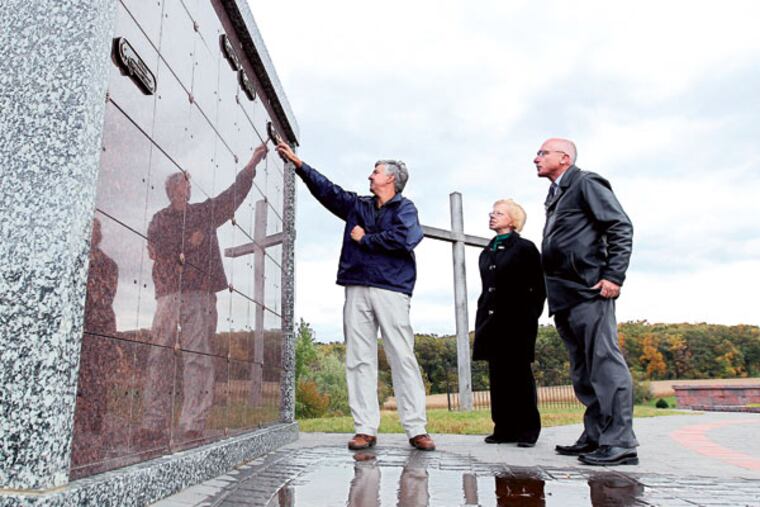Churches responding to uptick in cremation
Steve Morton read a few years ago that changing religious views, convenience, and the recession were leading more people to choose cremation. As the senior pastor of Hopewell United Methodist Church in Downingtown, he knew he had to respond.

Steve Morton read a few years ago that changing religious views, convenience, and the recession were leading more people to choose cremation. As the senior pastor of Hopewell United Methodist Church in Downingtown, he knew he had to respond.
"The church has got to get in there with something sacred and beautiful," Morton said he and other church officials thought. "I have so many church members where Mom is in the basement, or Dad is in the garage."
So the church opened a memorial garden and two columbaria last year for the cremated remains of congregants and community members. And the church has a long-term plan to build up to four more columbaria, which contain niches to hold urns.
In 2007, about 35 percent of people who died in the United States were cremated, according to the Cremation Association of North America. By 2017, 49 percent will be cremated.
As these numbers have increased, churches big and small have worked to offer attractive options for cremated remains. They are planting memorial gardens for scattering or burying what are known as cremains. They are designing permanent homes of different sizes and shapes for rows of urns.
Some churches have made these additions even if they do not have a cemetery for traditional burials.
Different teachings dictate what churches can do with cremains. For example, the Archdiocese of Philadelphia issued revised guidelines to parishes last year about cremation. It said remains cannot be scattered. They must be buried in a cemetery or encased in a columbarium or mausoleum.
Only some Jewish leaders permit cremation. In the Philadelphia area, about 20 percent of Jewish families who use Dignity Memorial's Jewish funeral homes and cemeteries choose cremation, said Eric Wolverton, the Pennsylvania regional president of Dignity Memorial, a national network of more than 2,000 funeral, cremation, and cemetery service providers.
Churches pass out brochures highlighting beautiful landscaping and natural views they can offer at their cemeteries and gardens. Some gardens even attract members of the community to walk through or sit and read.
The brochures also emphasize that choosing gardens or columbaria is less expensive than burial.The median cost of a funeral in the United States was about $7,000 in 2012, according to the National Funeral Directors Association. The average cost of an in-ground burial - including a stone, casket, excavation, and burial lot - at Hopewell United Methodist Church is $16,000. A niche in one of the church's columbaria is $1,600. Scattering in the garden is $350.
Many people choose cremation so they can postpone funeral services until family members can travel to the location, said Jim Foreman, manager of Paoli Presbyterian Church's memorial garden.
A brick wall around the edge of the garden there acts as a columbarium.
About 150 people plan for their cremated remains to be buried in the church's memorial garden, created in 1991. About 100 more have reserved space within the brick wall around the edge of the garden. The Episcopal Church of the Redeemer in Bryn Mawr has three cremations for every one full-bodied burial in its graveyard, said Jay Einspanier, the church's administrator.
Many people have bypassed the indoor columbarium the church has had for decades in favor of the memorial garden.
"It's just a nicer setting," Einspanier said.
At St. John's Evangelical Lutheran Church in Phoenixville, church and community members have reserved about half of the 112 niches available in the Columbarium Garden since the garden opened in November. The church of about 700 members plans to start phase II - with 112 more niches - in a couple of years. The third phase will follow.
When Hopewell United Methodist Church officials reserved 15 acres in 1960 for future expansion of the cemetery, they had no idea the expansion would be upward as well as outward, said Arnie Kring, chair of the "cemetery enhancement project."
Two granite and marble columbaria that each house 96 niches rise up on each side of a memorial garden and a labyrinth made of pavers where people can congregate. Including landscaping and driveway paving, the expansion cost nearly $130,000.
One of the columbarium niches belongs to Kim and Jim Schywstell, ages 54 and 56. They are the first in their families to choose cremation. They said they like the affordability and the elimination of the need for family members, who are spread throughout the country, to tend to graves.
"This is a gift for our children," Kim Schywstell said.
Debra Boyd, 61, recently traded in her burial plot at Hopewell for a niche in one of its columbaria.
"The joke here is that I have the penthouse," she said. "The top corner facing the east. It's a beautiful view from that corner."
(This article is corrected from an earlier version.)
BY THE NUMBERS
$7,000
Median cost of an in-ground burial in the United States
$16,000
Cost of an in-ground burial at Hopewell United Methodist Church
$1,600
Cost of a niche in a
Hopewell columbarium
$350
Cost of scattering ashes in the garden at Hopewell
EndText
610-313-8207 @MichaelleBond